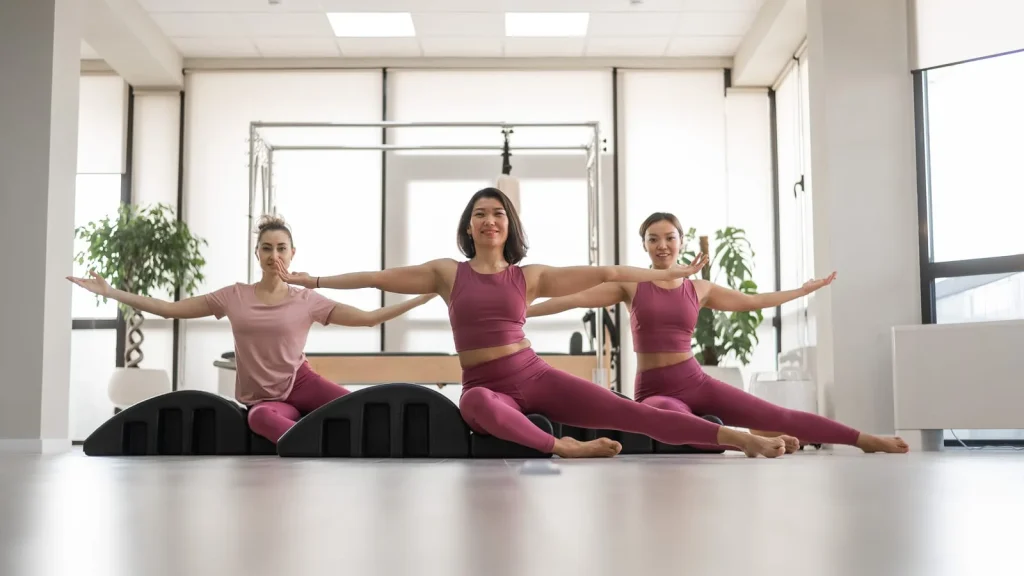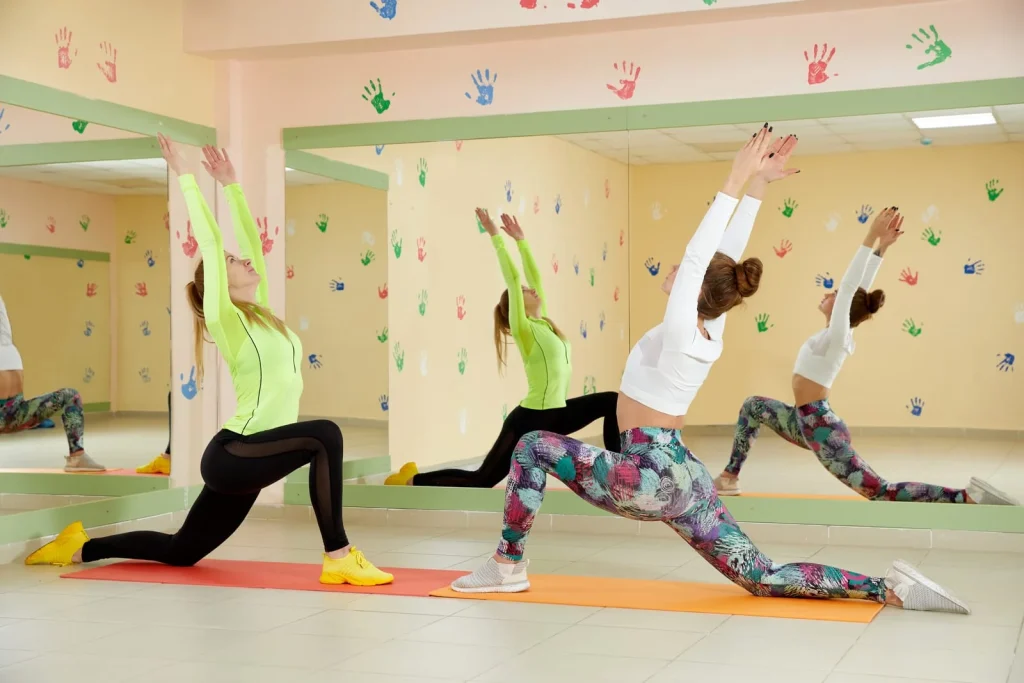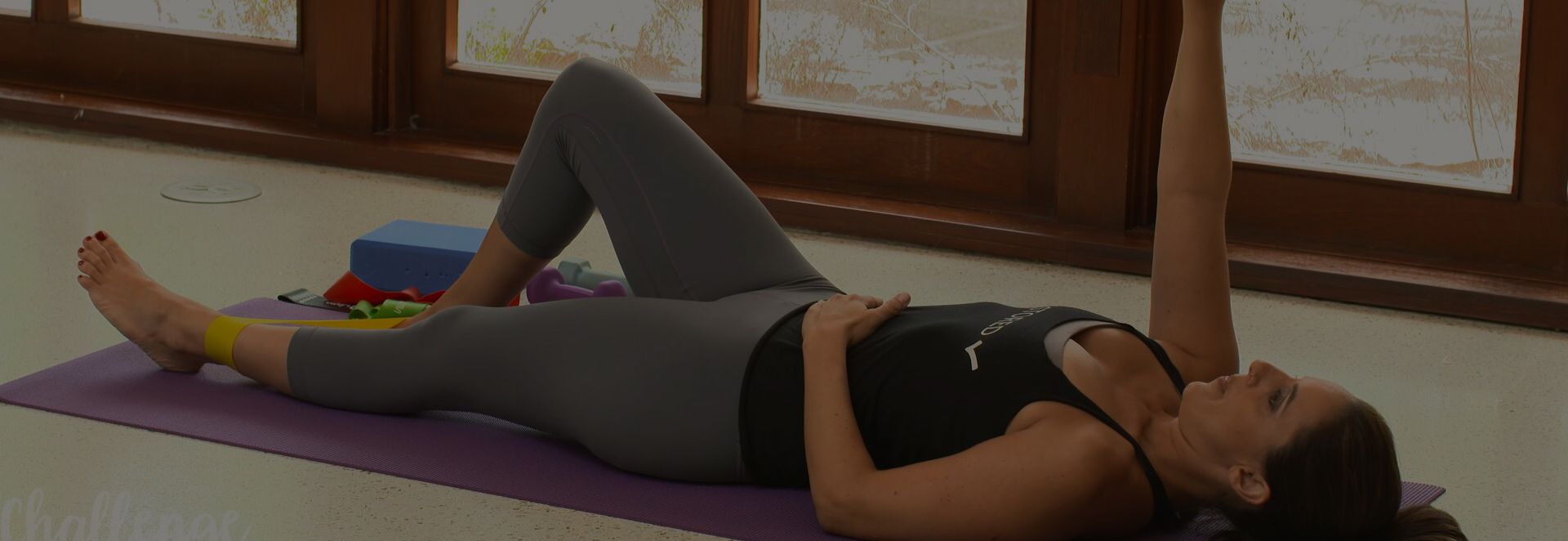Resources
- The Connection Between Exercise and Bloating: What Every Professional (and Their Clients) Need to Know
- How to Strengthen Pelvic Floor Safely
- Pelvic Floor Exercises for Constipation: Awareness, Movement, and Nervous System Relief
- High-Tone Pelvic Floor Dysfunction: Symptoms, Causes & Relief Tips
- How Menopause Affects the Pelvic Floor: Symptoms, Support & Hormonal Impact
- Tailbone Wagging for Tailbone Pain Relief and Pelvic Floor Mobility
- The Power of Tremoring: How Tension Release Exercises Support Your Nervous System
- Pelvic Floor Postpartum Exercises for Faster Recovery
- Navigating Coccyx Pain in Pregnancy: A Trimester-by-Trimester Guide
- Understanding Coccyx Pain: Symptoms, Causes, Healing and Prevention
- Pilates and Pelvic Floor Dysfunction: Is It the Solution You’re Seeking?
- Pelvic Floor Massage: A Comprehensive Guide
- Does Pilates Strengthen Pelvic Floor Muscles? A Comprehensive Guide
- Hypermobility and Pelvic Floor Health: What You Need to Know
- The Foot to Pelvic Floor Connection: A Whole-Body Approach to Movement and Health
- Understanding Pelvic Floor Pain After Running: Causes and Solutions for Professionals
- Top 5 Exercises to Strengthen the Pelvic Floor
- Do Squats Strengthen Pelvic Floor Muscles? Insights for Movement Professionals
- How Pelvic Floor Health Is Related to the Process of Moving from Arousal to Orgasm
- 5 Things I Wish People Knew About Your Pelvic Floor & Orgasm
- Pelvic Floor Tension: Everything You Need to Know
- How Running and Pelvic Floor Health Are Interconnected: What Every Runner Should Know
- Does Running Strengthen Pelvic Floor Muscles? Myths vs. Facts
- Understanding Urine Leakage Causes: Why It Happens and How to Manage It
- How to Strengthen Your Pelvic Floor: The Ultimate Guide
- Strengthening and Restorative Yoga Poses for Full Body Health
- Understanding Queefing: Causes, Symptoms, and Simple Prevention Tips
- How Do You Know if You Have a Weak Pelvic Floor
- What Does Pelvic Floor Pain Feel Like?
- How Can I Strengthen My Pelvic Floor Without Kegels?
- Pelvic Floor Stretches | 5 Quick Ways To Relax Your Pelvis
- Pelvic Floor Specialist | Finding Help To Heal Your Pelvis
- Is Pelvic Floor Repair Major Surgery? | Pelvic Health Guide
- Pelvic Floor Exercise
- How to Strengthen Pelvic Floor
- Pelvic Floor Therapy | Improving Your Pelvic Health
Resources
- The Connection Between Exercise and Bloating: What Every Professional (and Their Clients) Need to Know
- How to Strengthen Pelvic Floor Safely
- Pelvic Floor Exercises for Constipation: Awareness, Movement, and Nervous System Relief
- High-Tone Pelvic Floor Dysfunction: Symptoms, Causes & Relief Tips
- How Menopause Affects the Pelvic Floor: Symptoms, Support & Hormonal Impact
- Tailbone Wagging for Tailbone Pain Relief and Pelvic Floor Mobility
- The Power of Tremoring: How Tension Release Exercises Support Your Nervous System
- Pelvic Floor Postpartum Exercises for Faster Recovery
- Navigating Coccyx Pain in Pregnancy: A Trimester-by-Trimester Guide
- Understanding Coccyx Pain: Symptoms, Causes, Healing and Prevention
- Pilates and Pelvic Floor Dysfunction: Is It the Solution You’re Seeking?
- Pelvic Floor Massage: A Comprehensive Guide
- Does Pilates Strengthen Pelvic Floor Muscles? A Comprehensive Guide
- Hypermobility and Pelvic Floor Health: What You Need to Know
- The Foot to Pelvic Floor Connection: A Whole-Body Approach to Movement and Health
- Understanding Pelvic Floor Pain After Running: Causes and Solutions for Professionals
- Top 5 Exercises to Strengthen the Pelvic Floor
- Do Squats Strengthen Pelvic Floor Muscles? Insights for Movement Professionals
- How Pelvic Floor Health Is Related to the Process of Moving from Arousal to Orgasm
- 5 Things I Wish People Knew About Your Pelvic Floor & Orgasm
- Pelvic Floor Tension: Everything You Need to Know
- How Running and Pelvic Floor Health Are Interconnected: What Every Runner Should Know
- Does Running Strengthen Pelvic Floor Muscles? Myths vs. Facts
- Understanding Urine Leakage Causes: Why It Happens and How to Manage It
- How to Strengthen Your Pelvic Floor: The Ultimate Guide
- Strengthening and Restorative Yoga Poses for Full Body Health
- Understanding Queefing: Causes, Symptoms, and Simple Prevention Tips
- How Do You Know if You Have a Weak Pelvic Floor
- What Does Pelvic Floor Pain Feel Like?
- How Can I Strengthen My Pelvic Floor Without Kegels?
- Pelvic Floor Stretches | 5 Quick Ways To Relax Your Pelvis
- Pelvic Floor Specialist | Finding Help To Heal Your Pelvis
- Is Pelvic Floor Repair Major Surgery? | Pelvic Health Guide
- Pelvic Floor Exercise
- How to Strengthen Pelvic Floor
- Pelvic Floor Therapy | Improving Your Pelvic Health
5 Pilates Pelvic Floor Exercises You Don’t Want to Leave Out
By Lauren Ohayon 12/18/2024
6 Min Read
Pilates is a method of exercise that has been around for nearly a century. Throughout the decades, it has appealed to people from all walks of life looking for an accessible movement practice that balances strength with mobility and flexibility. One thing has held true through all of it: the practice of Pilates exercises has helped women and men build and maintain a strong pelvic floor! Modern approaches, like the Restore Your Core® program, draw inspiration from Pilates principles while incorporating additional techniques to address core and pelvic floor health comprehensively.

Why Are the Pelvic Floor Muscles Important?
The pelvic floor muscles play a vital role in core stability, bladder and bowel control, and sexual function. They support the pelvic organs and work in harmony with the diaphragm and deep core muscles to regulate intra-abdominal pressure during everyday activities like walking, lifting, or even breathing. Dysfunction in the pelvic floor can lead to issues like incontinence, pelvic pain, and prolapse, making its strength and flexibility essential for overall health and well-being. Incorporating Pilates exercises for pelvic floor muscles into your routine can help strengthen and support these critical muscles. Pilates emphasizes body awareness, alignment, and core strength, all of which support the health and function of the pelvic floor. It is particularly beneficial for the pelvic floor because it supports:
1. Core Activation and Integration
In Pilates, the core is often referred to as the “powerhouse,” and it includes the pelvic floor muscles along with the deep abdominals, diaphragm, and back muscles. Pilates focuses on activating and integrating these muscles together, which helps create stability in the pelvis and lower spine. By strengthening the entire core system, Pilates helps improve the function of the pelvic floor, reducing the risk of incontinence and pelvic organ prolapse. Restore Your Core® builds upon this foundational core activation approach by emphasizing functional integration of the pelvic floor into everyday movements and activities, beyond the mat.
2. Focus on Mind-Body Connection
Pilates promotes mindfulness, encouraging participants to engage and control muscles with precision. Each Pilates exercise emphasizes a connection between breath and movement, which enhances awareness of the pelvic floor muscles. This awareness is key to performing the exercise correctly so that the pelvic floor can learn to engage and relax in response to the movement.
3. Improved Posture and Alignment
Pilates promotes proper posture and spinal alignment, which can directly impact pelvic health. Poor posture, such as a tilted pelvis or slouching, can lead to excessive pressure on the pelvic floor, potentially contributing to pelvic floor dysfunction. Pilates exercises encourage elongation and balanced muscle engagement to minimize pressure on the pelvic floor and promote optimal muscle function. This, in turn, supports a well-balanced alignment of the body.
4. Breathing Techniques
Pilates teaches posterior-lateral breathing, which is the practice of breathing deeply into the diaphragm and ribcage rather than down into the belly. This expansive, three-dimensional breathing supports the pelvic floor by helping to regulate intra-abdominal pressure. Proper breathing also helps avoid over-contraction of the pelvic floor muscles, which can happen if someone holds their breath or bears down during exercise.
5. Strength and Length
Pilates exercises balance strengthening with lengthening, which is particularly important for the pelvic floor. Over-tightened pelvic floor muscles can lead to pain, pelvic floor dysfunction, and difficulty relaxing the muscles when needed. Pilates pelvic floor exercises help promote a strong and supple pelvic floor, leading to optimal function and control.
6. Improved Coordination
Pilates exercises often involve coordinated movements that require support from the pelvic floor and other core muscles. This improves the coordination between the pelvic floor, abdominals, diaphragm, and lower back, essential for maintaining pelvic floor health in daily life and during physical activities.
7. Gentle Rehabilitation and Postpartum Recovery
Pilates is particularly beneficial for people recovering from childbirth, as it allows them to gently rebuild pelvic floor strength without putting undue pressure on the body. Postpartum Pilates exercises can help improve pelvic floor function and support recovery by reawakening the core and pelvic muscles in a controlled, low-impact way. Pilates exercises are also great for those who are managing pelvic organ prolapse or experiencing incontinence, as it helps to restore optimal core and pelvic floor function. The Restore Your Core® program is especially effective for postpartum recovery, offering exercises designed to rebuild strength and reconnect with the pelvic floor after childbirth.
8. Prevention of Pelvic Floor Disorders
For those who haven’t yet experienced pelvic floor issues, Pilates exercises for pelvic floor can be a preventative measure. By strengthening and supporting the pelvic floor through proper movement patterns, Pilates can reduce the risk of incontinence, prolapse, and pelvic pain. This is especially important during pregnancy when the pelvic floor is under increased strain and in later life when pelvic floor function can decline due to hormonal changes or aging.
Okay, so now that you understand the importance of pelvic floor health and how Pilates is an excellent method to support it, which Pilates exercises are helpful that you can do during your workouts?
Restore Your Core® incorporates elements of Pilates, making it a well-rounded approach to your fitness routine. To further enhance your practice, here are five Pilates pelvic floor exercises to strengthen pelvic floor:

1. Bridging
The Bridge is a fundamental Pilates exercise for pelvic floor muscles, enhances pelvic mobility, and builds hip and glute strength. It also engages the core, improves spinal articulation, and promotes overall body control.
How to do it:
Set up your position:
- Lie flat on your back on a mat with your arms resting by your sides, palms facing down.
- Bend your knees and place your feet flat on the floor, hip-width apart, with your heels close enough to your glutes that your fingertips can graze them.
Engage your core:
- Inhale deeply, and as you exhale, gently engage your lower abdominals, pulling your navel inward and upward.
Lift into the bridge:
- Press your feet firmly into the mat and slowly roll your pelvis off the mat, lifting one vertebra at a time.
- Continue lifting until your hips form a straight line with your knees and shoulders, reaching your knees forward over your toes.
- Keep your glutes engaged and your shoulders relaxed, ensuring there’s no tension in your neck.
Lower with control:
- Inhale at the top, and as you exhale, slowly reverse the motion.
- Roll your spine back down one vertebra at a time, starting from the upper back and finishing with your pelvis gently returning to the mat.
Benefits for the pelvic floor:
The Bridge effectively engages the glutes, which are closely connected to the pelvic floor. As the glutes activate and strengthen during the lift, they stimulate and support the pelvic floor muscles. The controlled rolling motion also promotes pelvic mobility and helps develop the connection between the core and the pelvic floor, fostering better overall function.
Tips:
- Avoid arching your lower back; focus on smooth, controlled spinal articulation.
- Keep your movements slow and intentional, engaging your core throughout.
- Breathe steadily, using the exhale to guide the lifting and lowering motion.
Repetitions:
Perform 6–8 repetitions, moving with your breath and focusing on alignment and control.
2. Single Leg Circles
Single Leg Circles are a classic Pilates exercise that targets the hips, core, and legs while enhancing stability and mobility in the hip joint. This movement also challenges your core muscles to maintain control and stability throughout the exercise.
How to do it:
Set up your position:
- Lie on your back on a mat with your arms resting by your sides and palms facing down for support.
- Extend one leg toward the ceiling, keeping the knee straight or slightly bent for comfort. The opposite leg remains grounded on the floor.
- Ensure your pelvis is neutral and stable, with your lower back in neutral.
Engage your core:
- Inhale deeply, and as you exhale, engage your core muscles by gently pulling your lower abdominals inward and upward.
- Focus on maintaining a stable pelvis throughout the movement.
Perform the circles:
- Begin to circle the lifted leg in small, controlled motions, keeping the movement smooth and precise.
- Breathe evenly, inhaling as you begin the circle and exhaling as you complete it.
- Complete several circles in one direction, then reverse the motion for the same number of repetitions.
Switch sides:
- Lower the first leg to the floor and repeat the exercise with the opposite leg, ensuring the same level of control and focus.
How it targets the pelvic floor muscles:
The Single Leg Circle engages the core and pelvic stabilizers, including the pelvic floor muscles. By maintaining a stable pelvis and precise leg movements, the exercise promotes subtle contractions of the pelvic floor to maintain control and alignment. With proper core engagement, the pelvic floor works in harmony with the rest of the core to stabilize the body during the circular motion.
Tips:
- Keep the movement small and controlled, avoiding any rocking or tilting of the pelvis.
- Focus on lengthening your leg as it moves, imagining your foot tracing a smooth circle in the air.
- Adjust the size of the circle based on your mobility and ability to maintain stability.
Repetitions:
Perform 5–8 circles in each direction per leg, moving with your breath and maintaining focus on control and stability.
3. Swan
The Swan is a classic Pilates exercise that strengthens the posterior chain, including the spinal muscles, glutes, and hamstrings. It also engages the core, including the pelvic floor, to support the movement. This exercise is excellent for improving posture, flexibility, and counteracting the effects of prolonged sitting.
How to do it:
Set up your position:
- Lie face down on your mat with your legs extended straight behind you.
- Place your hands on the mat under your shoulders, with your elbows bent and close to your body.
Engage your core:
- Inhale deeply, and as you exhale, imagine blowing out 100 candles in a long, steady breath.
- Feel your lower abdominals lift gently upward, engaging your core without pressing your belly into the mat.
Begin the movement:
- Start by nodding your nose forward and slightly down, then roll your shoulders back and lift your chest off the floor.
- Use your upper back muscles to guide the movement, keeping your neck long and relaxed.
Extend into a backbend:
- Once you’ve lifted your chest as far as your upper back muscles allow, press gently into your hands to deepen the movement.
- Lift your torso into a comfortable backbend, keeping your shoulders relaxed and your gaze forward or slightly downward.
- Avoid pushing into discomfort or forcing your range of motion.
Lower with control:
- Inhale as you slowly reverse the movement, lowering your chest and head back to the floor with control.
Tips:
- Keep your legs and glutes relaxed to avoid excessive tension in the lower body.
- Focus on spinal length rather than height—imagine stretching your spine out as you lift.
- Move slowly and with control to avoid straining your back or shoulders.
Repetitions:
Perform 6–8 repetitions, moving with your breath and focusing on smooth, controlled movements.
Pelvic floor strengthening benefits: This Pilates exercise strengthens the pelvic floor by activating the deep abdominal muscles and the glute muscles, which support the activation of the pelvic floor.
4. Kneeling Side Kick
The Kneeling Side Kick is a versatile exercise that strengthens the core, glutes, hips, and thighs while enhancing balance, stability, and flexibility. This movement involves a controlled dynamic leg kick, emphasizing core engagement to build strength and coordination.
How to do it:
- Begin in a kneeling position on a mat with your knees aligned under your hips, about hip-width apart. Your feet can be flat on the mat or with toes tucked under for additional support.
- Place your hands on the mat for stability. Position them directly under your shoulders or slightly forward if needed for balance. Keep your back neutral and your shoulders relaxed, pulled down and away from your ears.
- Shift your weight onto one knee and the hand on the same side of your body. Extend the opposite leg out to the side, straight and in line with your body. Place your free hand on your hip for support. Your body should resemble a kneeling variation of a side plank, with your extended leg aligned with your torso.
- Engage your core and lift the extended leg to hip height. Maintain a stable pelvis, ensuring it doesn’t tilt or rotate as you move.
- From the lifted position, swing your leg forward in a controlled kick, keeping your foot parallel to the floor. Avoid excessive swinging or jerking motions. Focus on smooth, precise movements.
- Return the leg to the starting position, then move it backward into the space behind you, extending the hip without arching your lower back. Keep your hips stable and squared throughout the motion.
Effectiveness for pelvic floor engagement: This dynamic Pilates exercise requires stability and control to execute well. The core muscles, and especially the pelvic floor muscles, engage in response to load and the need to stabilize during movement.
5. Seated Spine Stretch Side
The Seated Spine Stretch Side is a Pilates exercise designed to improve spinal flexibility, lateral strength, and core control. This movement primarily targets the obliques, back, and shoulders, promoting better posture and alignment. It’s a variation of the traditional Spine Stretch Forward, emphasizing lateral engagement and stretching the sides of the body.
How to do it:
Set up your position:
- Sit tall on a mat or a comfortable surface with your legs extended straight in front of you.
- If it’s challenging to sit upright, slightly bend your knees or sit on a yoga block or bolster for added support.
- Keep your feet flexed, hip-width apart, and your heels aligned with your sit bones (the bones in your buttocks).
Position your arms:
- Extend your arms straight out to the sides at shoulder height, with palms facing forward.
- Keep your arms straight but not locked, and relax your shoulders away from your ears.
Engage your core:
- Inhale deeply, and as you exhale, imagine blowing through a straw to blow out candles on a birthday cake.
- Feel your lower abs tighten and gently lift upward to support your movement.
Side bend:
- Begin to bend to one side, reaching one hand toward the floor for support while the opposite arm stretches up and over toward the same side.
- Focus on creating a lateral arc through your torso, extending from your hips to your fingertips.
Maintain form:
- Avoid leaning forward; the movement should emphasize a pure side bend.
- Lengthen the side of your body as you stretch, keeping your spine long and shoulders open.
- Use your bottom hand for light support rather than bearing your full weight.
Return to center:
- Inhale as you slowly return to the starting position, maintaining control through your core.
- Repeat on the other side, alternating for 4-6 repetitions per side.
Tips:
- Move slowly and with control to avoid collapsing into the stretch.
- Focus on engaging your lateral muscles to deepen the stretch and maintain alignment.
Benefits for pelvic floor flexibility and toning: Spine Stretch Side is considered a Pilates pelvic floor exercise because it encourages gentle stability while lengthening and strengthening the many torso muscles that share connections with the pelvic floor. By increasing flexibility in the torso and hip muscles, the pelvic floor is able to become more supple and toned.
Pilates is an excellent method for strengthening the pelvic floor muscles; it emphasizes core activation, mindful movement, proper alignment, and breathing techniques. These five Pilates pelvic floor exercises focus on specific areas of your body to form a balanced and comprehensive movement practice. Through a combination of strengthening and lengthening, Pilates is a safe and effective approach to optimal pelvic floor health.
FAQ
1. Can Pilates exercises replace medical treatment for pelvic floor disorders?
For people experiencing pelvic floor dysfunction, working with a pelvic health physiotherapist can help restore proper function. Pilates may be recommended by the physiotherapist as a supplement to the therapeutic work.
2. Are there any Pilates exercises I should avoid if I have pelvic floor issues?
If you’re currently restoring pelvic floor health, avoid exercises that may cause bearing down or create excessive pressure on the pelvic floor. Additionally, consulting with a pelvic health physiotherapist can provide personalized guidance to ensure your practice supports your recovery and long-term health.
3. How do I know if I am performing Pilates pelvic floor exercises correctly?
By practicing the breathing technique taught in Restore Your Core® while performing your Pilates exercise, you should feel supported, elongated, and stable throughout your hips, pelvis and low back. If you notice bulging or bearing down in your lower abdominals while doing the exercises, spend more time on the foundational breathing before continuing with Pilates.
4. How often should I perform Pilates exercises for pelvic floor strengthening?
Aim to establish a schedule you can maintain, with a typical recommendation of practicing 3-5 days per week. That said, any consistent, supportive movement is beneficial and worthwhile.
5. How long does it take to see results from pelvic floor Pilates exercises?
When practiced in conjunction with Restore Your Core®, you may begin to notice positive changes in as few as two weeks.
6. What other benefits can Pilates offer besides strengthening the pelvic floor?
Pilates is wonderful for maintaining full body strength, flexibility and mobility. In addition to core strengthening, it targets the arms, legs, hips and torso, creating a complete workout for the entire body. Because it is considered a mind-body exercise method, it can also help support nervous system regulation, mindfulness, mental and digestive health.



